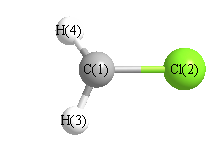Jump to
S1C2
Energy calculated at B2PLYP=FULL/6-31G(2df,p)
| | hartrees |
|---|
| Energy at 0K | -499.262065 |
| Energy at 298.15K | |
| HF Energy | -499.150934 |
| Nuclear repulsion energy | 45.400960 |
The energy at 298.15K was derived from the energy at 0K
and an integrated heat capacity that used the calculated vibrational frequencies.
Vibrational Frequencies calculated at B2PLYP=FULL/6-31G(2df,p)
| Mode Number |
Symmetry |
Frequency
(cm-1) |
Scaled Frequency
(cm-1) |
IR Intensities
(km mol-1) |
Raman Act
(Å4/u) |
Dep P |
Dep U |
|---|
| 1 |
A' |
3220 |
3220 |
5.70 |
92.70 |
0.12 |
0.21 |
| 2 |
A' |
1429 |
1429 |
12.79 |
3.24 |
0.66 |
0.79 |
| 3 |
A' |
853 |
853 |
34.30 |
7.19 |
0.20 |
0.33 |
| 4 |
A' |
203 |
203 |
62.68 |
0.62 |
0.26 |
0.42 |
| 5 |
A" |
3375 |
3375 |
0.10 |
46.53 |
0.75 |
0.86 |
| 6 |
A" |
1007 |
1007 |
0.04 |
3.65 |
0.75 |
0.86 |
Unscaled Zero Point Vibrational Energy (zpe) 5042.9 cm
-1
Scaled (by 1) Zero Point Vibrational Energy (zpe) 5042.9 cm
-1
See section
III.C.1 List or set vibrational scaling factors
to change the scale factors used here.
See section
III.C.2
Calculate a vibrational scaling factor for a given set of molecules
to determine the least squares best scaling factor.
Geometric Data calculated at B2PLYP=FULL/6-31G(2df,p)
Point Group is Cs
Cartesians (Å)
| Atom |
x (Å) |
y (Å) |
z (Å) |
|---|
| C1 |
-0.007 |
1.118 |
0.000 |
| Cl2 |
-0.007 |
-0.584 |
0.000 |
| H3 |
0.084 |
1.614 |
0.950 |
| H4 |
0.084 |
1.614 |
-0.950 |
Atom - Atom Distances (Å)
| |
C1 |
Cl2 |
H3 |
H4 |
| C1 | | 1.7019 | 1.0762 | 1.0762 |
Cl2 | 1.7019 | | 2.3969 | 2.3969 | H3 | 1.0762 | 2.3969 | | 1.9008 | H4 | 1.0762 | 2.3969 | 1.9008 | |
 More geometry information
More geometry information
Calculated Bond Angles
| atom1 |
atom2 |
atom3 |
angle |
|
atom1 |
atom2 |
atom3 |
angle |
| Br2 |
C1 |
H3 |
117.480 |
|
Br2 |
C1 |
H4 |
117.480 |
| H3 |
C1 |
H4 |
124.038 |
|
Electronic energy levels
Charges, Dipole, Quadrupole and Polarizability
Jump to
S1C1
Energy calculated at B2PLYP=FULL/6-31G(2df,p)
| | hartrees |
|---|
| Energy at 0K | -499.262056 |
| Energy at 298.15K | |
| HF Energy | -499.150909 |
| Nuclear repulsion energy | 45.417005 |
The energy at 298.15K was derived from the energy at 0K
and an integrated heat capacity that used the calculated vibrational frequencies.
Vibrational Frequencies calculated at B2PLYP=FULL/6-31G(2df,p)
| Mode Number |
Symmetry |
Frequency
(cm-1) |
Scaled Frequency
(cm-1) |
IR Intensities
(km mol-1) |
Raman Act
(Å4/u) |
Dep P |
Dep U |
|---|
| 1 |
A1 |
3223 |
3223 |
5.06 |
92.19 |
0.12 |
0.21 |
| 2 |
A1 |
1429 |
1429 |
12.95 |
|
|
|
| 3 |
A1 |
854 |
854 |
33.49 |
|
|
|
| 4 |
B1 |
145i |
145i |
66.65 |
|
|
|
| 5 |
B2 |
3380 |
3380 |
0.20 |
|
|
|
| 6 |
B2 |
1004 |
1004 |
0.04 |
|
|
|
Unscaled Zero Point Vibrational Energy (zpe) 4872.4 cm
-1
Scaled (by 1) Zero Point Vibrational Energy (zpe) 4872.4 cm
-1
See section
III.C.1 List or set vibrational scaling factors
to change the scale factors used here.
See section
III.C.2
Calculate a vibrational scaling factor for a given set of molecules
to determine the least squares best scaling factor.
Geometric Data calculated at B2PLYP=FULL/6-31G(2df,p)
Point Group is C2v
Cartesians (Å)
| Atom |
x (Å) |
y (Å) |
z (Å) |
|---|
| C1 |
0.000 |
0.000 |
-1.116 |
| Cl2 |
0.000 |
0.000 |
0.584 |
| H3 |
0.000 |
0.952 |
-1.618 |
| H4 |
0.000 |
-0.952 |
-1.618 |
Atom - Atom Distances (Å)
| |
C1 |
Cl2 |
H3 |
H4 |
| C1 | | 1.7007 | 1.0759 | 1.0759 |
Cl2 | 1.7007 | | 2.3991 | 2.3991 | H3 | 1.0759 | 2.3991 | | 1.9036 | H4 | 1.0759 | 2.3991 | 1.9036 | |
 More geometry information
More geometry information
Calculated Bond Angles
| atom1 |
atom2 |
atom3 |
angle |
|
atom1 |
atom2 |
atom3 |
angle |
| Br2 |
C1 |
H3 |
117.787 |
|
Br2 |
C1 |
H4 |
117.787 |
| H3 |
C1 |
H4 |
124.427 |
|
Electronic energy levels
Charges, Dipole, Quadrupole and Polarizability
